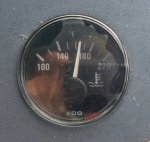I still have the original pump on my 97 454 (SJE cooled) engine. If I ever replaced the pump, I would definitely get a (regular) pump at the local autoparts store.
Ted, before I installed the (same) SJE cooling system on my 454 in 2006, and because I had my engine on a stand, I removed all the core plugs with the water pump removed.
I flushed the engine block and heads (block multiple times) and actually did get a fair amount of sand and sediment out of the lower areas in the block around the cyls.
With the core plugs removed and using a flashlight, I was actually able to see some of it (where you could see into the cooling area around the hole) that did not just "wash" out with the movement of the water. That sand and sediment was of course "mixed" with rust, and where I could poke with a wire, I was able to break what I could get to loose.
This was with only 122 hrs of open-cooled non-salt water operation.
I wonder if it wouldn't be a bad idea to do a hot flush with FORD VC-9, Cummins RESTORE or other equivalent rust removal "stuff"
Also, many of the engine coolants will precipitate silicate "drop-out" where the stuff actually makes a "goo" that will begin to clog passages if they get bad enough.
There are different coolant flush products that will remove the silicates and rust.
here's one that should be available locally.....
https://www.cumminsfiltration.com/south-pacific/cooling-system-cleaners




























